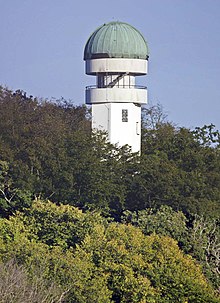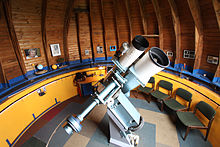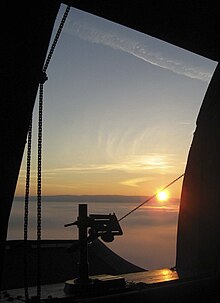Rothwesten public observatory
The Rothwesten public observatory is located near Rothwesten in the northern Hessian district of Kassel . Since the public observatory was completed in 1963, it has been considered a valuable cultural facility for the Kassel area .
Designed from the start as a free educational facility , the observatory is available to visitors with guided tours and events.
Geographical location
The public observatory Rothwesten is located in the municipality of Fuldatal above the district of Rothwesten on the observation tower at 300.7 m above sea level. NHN high Häusensberg .
history
Georg Spitzer planned to build a public observatory as early as the 1950s. On the initiative of the Rothwestern mayor Fritz Kranke, the observatory was to be located on the Häusensberg. Up until 1912 a lookout tower had already stood at this point, which suddenly collapsed and was not rebuilt.
In 1959 the construction of the new observation tower began, on the top of which the observatory should be located. Parallel to the construction of the tower by a Rothwestern construction company, Georg Spitzer worked together to assemble the wooden dome and cover it with a copper skin on a meadow below the Häusensberg. In 1962 the construction work on the tower was finished. The finished dome now had to be lifted onto the tower, but this turned out to be more difficult than initially thought. Because the original plan to put the entire dome on the tower with a helicopter of the American armed forces was shattered by the Cuban Missile Crisis. So there was nothing left but to split the dome in half and pull it up the hill to the base of the tower with a tractor and flatbed truck. From there, the dome halves were pulled up on the outside of the scaffolding using a cable winch and placed on the previously assembled running ring. On September 15, 1963, the observatory was inaugurated with a ceremony. In the following years the public observatory established itself as a private educational institution, regular tours and events on special events became an integral part of the cultural offerings in the district and beyond.
After the death of Georg Spitzer in 1989, the observatory was continued by his wife Friedel Spitzer. In 1991, after 28 years of operation, repair work on the copper sheet skin of the dome had to be carried out for the first time, and at the same time the municipality of Fuldatal carried out maintenance work on the tower. In 2005 the interior of the dome was renovated. Angelika Spitzer-Klinger has been running the observatory together with a group of volunteers since 2007. Wind and weather made it necessary to renovate the tower facade again in 2012. The public observatory celebrated its 50th anniversary in 2013 with several events.
The observatory received a special kind of honor in June 2019 when it took first place among 50 competitors in the online competition of the Volksbank Göttingen Kassel 'Treasure of the Region' and was able to win the main prize.
In autumn 2019, both the dome room and the walk-in pinhole camera were renovated.
Instruments
The Volkssternwarte Rothwesten has three telescopes that have different properties and can therefore also be used for various observation tasks:
- First a Newtonian telescope (reflector) with a mirror diameter of 210 mm and a weight of 25 kg. The device was built by Georg Spitzer at the time and works just as it did 50 years ago. With a focal length of 2100 mm (the focal ratio is f / 10, image errors are hardly significant with such large focal ratios) and an excellent mirror, it is mainly used for observing and photographing planets and double stars.
- The second reflector telescope , with a mirror diameter of 300 mm and an aperture ratio of f / 5.6, is significantly more powerful and particularly suitable for observing faint galaxies, gas nebulae and star clusters ( deep-sky objects ). The focal length of this Newtonian mirror telescope is 1700 mm. Tube and mirror bring it together to an impressive weight of 48 kg.
- A Meade ED APO refractor ( lens telescope ) with a 127 mm aperture and a focal length of 1140 mm (focal ratio f / 9.0) is used to observe sunspots .
Compared to mirror optics, lens telescopes have a higher contrast because there are no optical elements in the beam path. In the case of reflector telescopes, on the other hand, the secondary mirror is attached in the center of the tube and thus causes the main mirror to be shadowed (obstruction). Simple single lenses and achromatic refractors show a more or less strong color error ( chromatic aberration ), which can be seen e.g. B. is noticeable as a clear color fringing around stars. By using an ED element (glass with added fluoride) this color fringing can be almost completely eliminated. Such systems are also called apochromatic .
- A powerful industrial video camera is also available for recording objects in the solar system .
- A spectroscope can be used to view spectra or Fraunhofer lines.
- Planetarium programs, computers and LCD projectors support the work on the devices. If necessary, simulations and films are shown to illustrate celestial mechanical relationships or to honor special events. So z. B. a solar or lunar eclipse can be transmitted to a screen with the help of the video camera and projector.
Walk-in camera
In 2012, the top room in the tower was redesigned so that a walk-in camera was created for a maximum of 5 to 6 people. The camera is particularly well suited to demonstrate the essential features and differences between pinhole and lens cameras . For this purpose, the room can be completely darkened, only an opening in front of the window remains free and optionally accepts an adjustable pinhole - the room then fulfills the function of a pinhole camera - or a Fraunhofer lens with 60 mm and 900 mm focal length and then functions as a Lens camera. The diameter of the perforated diaphragm is 3 to 10 mm. In both cases, the image of the landscape is captured with the help of a screen and can be viewed by the visitors, who are, so to speak, in the camera housing itself.
Sufficient dark adaptation of the eye is required in the pinhole camera so that the visitors have to stay in the completely darkened room for about two minutes; Incidentally, the eye only achieves maximum adaptation after about 30 minutes. The darker the room and the better the dark adaptation, the more clearly the projected image can then be perceived.
In contrast to the classic pinhole camera, the lens camera generates a comparatively bright image, so that the adaptation of the eye is not critical and the function of the camera is already possible in a semi-darkened room (with restrictions). Depending on the weather, the results of the camera experiment are of very different quality. On cloudy days or at dusk, the camera image is dark and low in contrast. On sunny days, on the other hand, the camera impresses with “bright”, high-contrast and sharp images.
Spectroscopy
In addition, the walk-in camera is also used as a simple "spectroscopic laboratory" to demonstrate the spectra of different radiation sources. This includes both continuous spectra and line spectra , for example of mercury , sodium or single-color ( monochromatic ) light from artificial light sources. In addition, the effects of color and line filters can be clearly demonstrated.
opening hours
The observatory opens on Saturdays under a cloudless sky by prior arrangement.
| Period | Beginning of the tours |
|---|---|
| January February March | 8:00 p.m. |
| April | 9:00 p.m. |
| May June July August | Guided tours on request |
| September | 9:00 p.m. |
| October November December | 8:00 p.m. |
Individual evidence
- ↑ Map services of the Federal Agency for Nature Conservation ( information )
- ↑ Stars and Space 23 , No. 11, 1984, visit to the Rothwesten observatory , p. 589 ff.
- ^ Stars and Space 9 , 2013, Die Volkssternwarte Rothwesten. A family business turns 50 , pp. 84–87.
literature
- G. Spitzer: 20 years of the Rothwesten public observatory 1963–1983, 1983.
- R. Schwebel: Volkssternwarte Rothwesten, 1991.
- A. Gerlach, F. Sohl, K. Spitzer, R. Schwebel, H. Mai: 30 years of the Rothwesten public observatory, a foray through the universe and the history of the observatory, 1993.
- F. Spitzer: Rothwesten observatory, A foray through the universe and the history of the observatory, 1998.
- R. Gerstheimer: So let's be curious, Die Volkssternwarte Rothwesten, 2013.
Web links
- Volkssternwarte Rothwesten (official homepage)
Coordinates: 51 ° 23 '21.1 " N , 9 ° 30' 49.4" E


